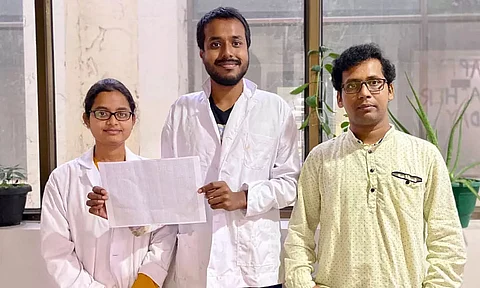
- Home
- Live Blog
- Breaking News
- Top Headlines
- Cities
- NE News
- Sentinel Media
- Sports
- Education
- Jobs

Guwahati: The researchers from the Indian Institute of Technology (IIT), Guwahati have developed a new efficient method to harvest drinking water from humid air.
The team of scientists from IIT-G is led by Dr Uttam Manna, Associate Professor, Chemistry department and Centre of Nanotechnology, IIT Guwahati, along with his research scholars Mr Kousik Maji, Mr Avijit Das, and Ms Manideepa Dhar.
The findings of the research were published in the prestigious journal of The Royal Society of Chemistry.
Following the water scarcity around the world, various attempts have been made to collect and conserve water through several non-traditional means.
Dr Uttam Manna explains that the technique used to harvest water from thin air uses the concept of hydrophobicity or water-repelling nature of some materials. The concept of hydrophobicity can be understood by taking the example of a lotus leaf. The lotus leaf is water repellent because there is a layer of trapped air between the leaf surface and the water droplet, which causes the droplet to slide off the leaf. However simple hydrophobicity such as this is unsuitable for water harvesting from highly humid environments because high moisture content can displace the trapped air and cause permanent damage. Instead, researchers mimic the pitcher plant, an 'insect-eating' plant, that has a slippery surface that causes insects that land on it to fall into its tube-shaped structure, to be digested. In the past geometries of Rice leaves and cacti are associated with 'Slippery Liquid-Infused Porous Surface(s)' or SLIPS to improve the water harvesting performance.
For the first-time-ever, the research team from IIT-G used the concept of chemically patterned SLIPS, to harvest water from moist air. A patterned hydrophilic SLIP was produced by the researchers by spraying a sponge-like porous polymeric material on top of a simple A4 printer paper. Further, chemically modulated hydrophilic spots were associated on the coating prior to lubricating with two distinct types of oils – natural olive oil and synthetic krytox. This surface could harvest water from foggy/water vapour laden air without the need for any cooling arrangement.
Dr Manna said that they have produced a "highly efficient water harvesting interface where the fog collecting rate is as high as 4400±190 mg/cm2/h."
When the researchers compared the performance of their pitcher-plant inspired SLIPS materials with other bio-inspired ideas, they found theirs to be superior in terms of efficiency of water harvesting.
The inexpensive method of harvesting water from the water vapour can further eliminate the water scarcity issues in the country.